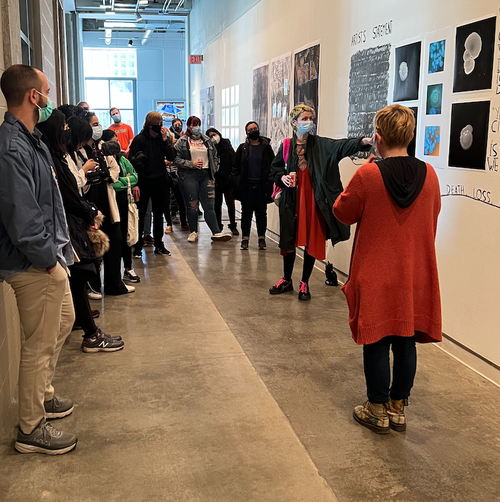
by Heidi Hehnly and Boryana Rossa
The CHIMERA exhibition, displayed during April inside the Shaffer Art Building, featured finished works and works in progress made by students and artists who utilize techniques and knowledge from the field of biological sciences, apply discussion from humanities and look for visual and textual expression that comes from the arts.
The exhibition emanated from Syracuse University's first ever bio-art class, co-taught by biology professor Heidi Hehnly and resident artist in the Hehnly Lab, Boryana Rossa, who is an associate professor in the College of Visual and Performing Arts. Both the class and art show were a labor of love for Hehnly lab members Nikhila Krishnan, Debadrita Pal, Abrar Aljiboury, Mike Bates and Favour Ononiwu, who worked closely with bio-art students.
During the global pandemic, the need for an integrated approach to education that includes both art and science has become imperative for fighting collective distrust in science. The attempt is to create a widely accessible view of the work done in scientific labs and open discussion about its social importance that comes from both sciences and the arts.
Students in the bio-art class, who have scientific or artistic backgrounds, studied examples of bio-art, had hands-on experience with microscopy and other biological techniques, and discussed their work reaching beyond their disciplines. The works in the exhibition presented varieties of topics, starting with self-portraits, portraits of ecological systems, visual exploration of macro and micro worlds, ethical and personal exploration of the role of the scientist in the society, and the body as a political arena.

Guest artists were presented with signature and award-winning works. Jennifer Willet looked at the topic of co-existence, play and collaboration of human and microbial worlds, Paul Vanouse reflected upon industrial society’s shift from human and machine labor to forms of microbial manufacturing, and Adam Zaretsky presented “The Errorarium,” a device for exploring the gamification of the forced genetic errors that may appear in chamber-grown botanica.
CHIMERA was part of the programming of the Bio-Art Mixer, where faculty and graduate students share their research or look at it from the perspective of a different discipline. The Bio-Art Mixer was initiated by Heidi Hehnly and Boryana Rossa.
The exhibition was supported by a CUSE Seed Grant, the Department of Film and Media Arts and the Department of Biology.
